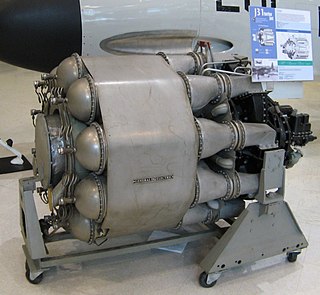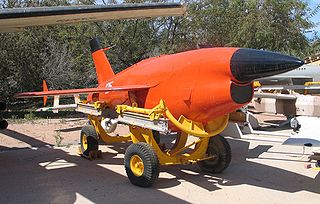
A jet engine is a type of reaction engine, discharging a fast-moving jet of heated gas that generates thrust by jet propulsion. While this broad definition may include rocket, water jet, and hybrid propulsion, the term jet engine typically refers to an internal combustion air-breathing jet engine such as a turbojet, turbofan, ramjet, pulse jet, or scramjet. In general, jet engines are internal combustion engines.

The turbojet is an airbreathing jet engine which is typically used in aircraft. It consists of a gas turbine with a propelling nozzle. The gas turbine has an air inlet which includes inlet guide vanes, a compressor, a combustion chamber, and a turbine. The compressed air from the compressor is heated by burning fuel in the combustion chamber and then allowed to expand through the turbine. The turbine exhaust is then expanded in the propelling nozzle where it is accelerated to high speed to provide thrust. Two engineers, Frank Whittle in the United Kingdom and Hans von Ohain in Germany, developed the concept independently into practical engines during the late 1930s.

The Rolls-Royce RB.44 Tay is a British turbojet engine of the 1940s, an enlarged version of the Rolls-Royce Nene designed at the request of Pratt & Whitney. It saw no use by British production aircraft but the design was licence built by Pratt & Whitney as the J48, and by Hispano-Suiza as the Verdon.

The Rolls-Royce RB.37 Derwent is a 1940s British centrifugal compressor turbojet engine, the second Rolls-Royce jet engine to enter production. It was an improved version of the Rolls-Royce Welland, which itself was a renamed version of Frank Whittle's Power Jets W.2B. Rolls-Royce inherited the Derwent design from Rover when they took over their jet engine development in 1943.

The BQM-74 Chukar is a series of aerial target drones produced by Northrop. The Chukar has gone through three major revisions, including the initial MQM-74A Chukar I, the MQM-74C Chukar II, and the BQM-74C Chukar III. They are recoverable, remote controlled, subsonic aerial target, capable of speeds up to Mach 0.86 and altitudes from 30 to 40,000 ft.

The General Electric J31 was the first jet engine to be mass-produced in the United States.

The Heinkel HeS 3 was the world's first operational jet engine to power an aircraft. Designed by Hans von Ohain while working at Heinkel, the engine first flew as the primary power of the Heinkel He 178, piloted by Erich Warsitz on 27 August 1939. Although successful, the engine had too little thrust to be really useful, and work started on the more powerful Heinkel HeS 8 as their first production design.

The Ryan Firebee is a series of target drones developed by the Ryan Aeronautical Company beginning in 1951. It was one of the first jet-propelled drones, and remains one of the most widely used target drones ever built.

The Turbomeca Marboré is a small turbojet engine that was produced by Turbomeca from the 1950s into the 1970s. The most popular uses of this engine were in the Fouga CM.170 Magister and the Morane-Saulnier MS.760 Paris. It was also licensed for production in the United States as the Teledyne CAE J69.

The CFE CFE738 is a small turbofan engine aimed at the business/commuter jet market manufactured by the CFE Company, and is used on the Dassault Falcon 2000.

The Pratt & Whitney J48 is a turbojet engine developed by Pratt & Whitney as a license-built version of the Rolls-Royce Tay. The Tay/J48 was an enlarged development of the Rolls-Royce Nene.

The Fairchild J44 was a small turbojet developed in the 1940s by the Fairchild Engine Division.

The Teledyne CAE J69 was a small turbojet engine originally produced by Continental Aviation and Engineering (CAE) under license from Turbomeca. The J69 was a development of the Turbomeca Marboré II. It powered a number of U.S. drones, missiles and small aircraft. The engine was later produced by Teledyne CAE. The J69 was also developed into the Teledyne CAE J100 turbojet optimized for operation at higher altitudes.

The Microturbo TRI 60 is a small, expendable turbojet engine developed for use in cruise missiles, target drones, and other small unmanned air vehicles. Variants of this engine produce from 3.5 to 5.3 kN of thrust. The engine first ran in 1974.

The Beechcraft MQM-107 Streaker is a reusable, turbojet powered, target towing drone primarily used by the United States Army and the United States Air Force for testing and training. The US Army uses the drone for testing various surface-to-air missile systems such as the FIM-92 Stinger and the MIM-104 Patriot. The US Air Force uses them in practice engagements for their air-to-air missiles like the AIM-9 Sidewinder and the AIM-120 AMRAAM.

The Teledyne CAE J402 is a small turbojet engine. Several variants have been developed to power unmanned air vehicles such as missiles and target drones. Developed in the 1970s for the Harpoon anti-ship missile, the J402 was the first jet engine to be designed as a "wooden round", meaning that the engine had to be able to sit for long periods without maintenance or inspection and work right away.

The NSRDC XBQM-108A was an experimental VTOL unmanned aerial vehicle developed by the United States Navy during the 1970s. Although the XBQM-108A successfully conducted unmanned, tethered flight tests and the project was canceled before any free flights could be conducted.
The West Engineering XJ38 was a small turbojet engine created by modifying World War II-surplus aircraft engine turbosuperchargers. Intended to be a cheap method of producing jet engines for target drones for the United States Navy, the latter lost interest in the project, which was soon discontinued because of lack of funding.

The Turbomeca Arbizon is a small turbojet engine used to power the Otomat anti-shipping missile. Developed from the Turbomeca Turmo the Arbizon was first made public in 1970 by the French manufacturer Turbomeca, by 1978 the engine had been improved to produce just over 3.5 kN thrust (800 lbf) with a stated service life of 30 hours.
The General Electric I-A was the first working jet engine in the United States, manufactured by General Electric (GE) and achieving its first run on April 18, 1942.


















